Abstract
The nonclassical major histocompatibility complex class II molecule HLA-DM (DM) has recently been shown to play a central role in the class II-associated antigen presentation pathway: DM releases invariant chain-derived CLIP peptides (class II-associated invariant chain protein peptide) from HLA-DR (DR) molecules and thereby facilitates loading with antigenic peptides. Some observations have led to the suggestion that DM acts in a catalytic manner, but so far direct proof is missing. Here, we investigated in vitro the kinetics of exchange of endogenously bound CLIP for various peptides on DR1 and DR2a molecules: we found that in the presence of DM the peptide loading process follows Michaelis-Menten kinetics with turnover numbers of 3-12 DR molecules per minute per DM molecule, and with KM values of 500-1000 nM. In addition, surface plasmon resonance measurements showed that DM interacts efficiently with DR-CLIP complexes but only weakly with DR-peptide complexes isolated from DM-positive cells. Taken together, our data provide evidence that DM functions as an enzyme-like catalyst of peptide exchange and favors the generation of long-lived DR-peptide complexes that are no longer substrates for DM.
Full text
PDF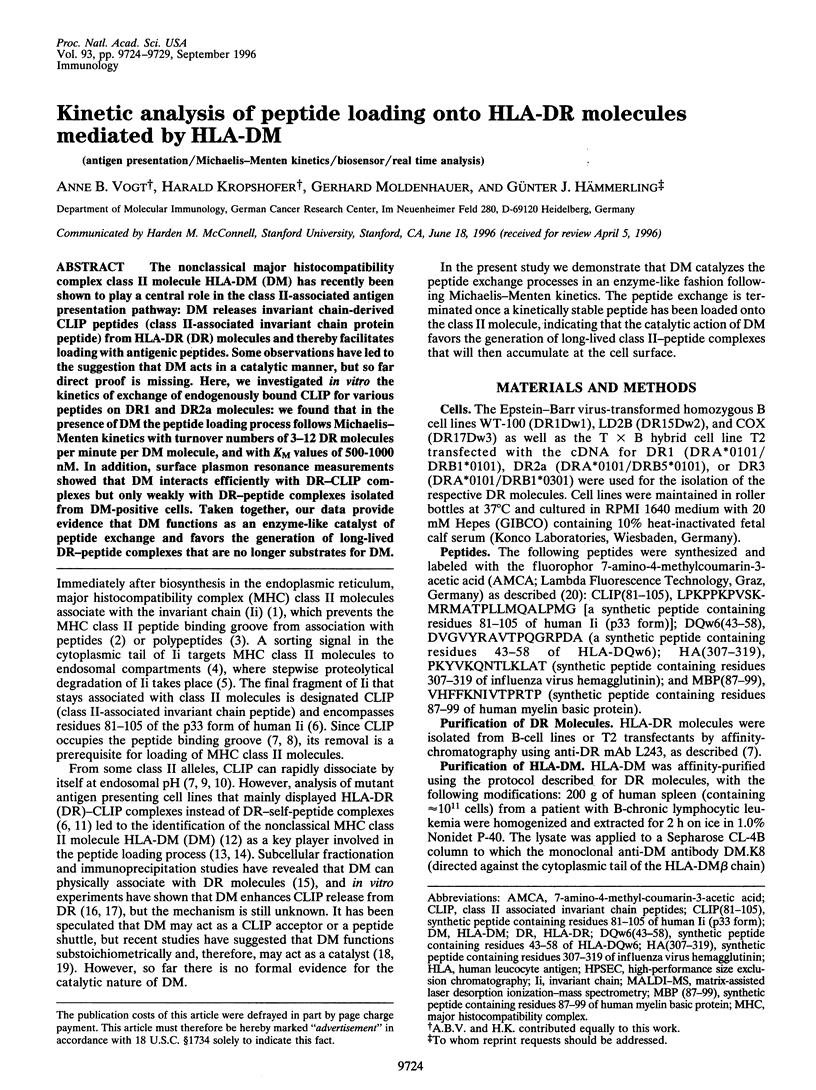
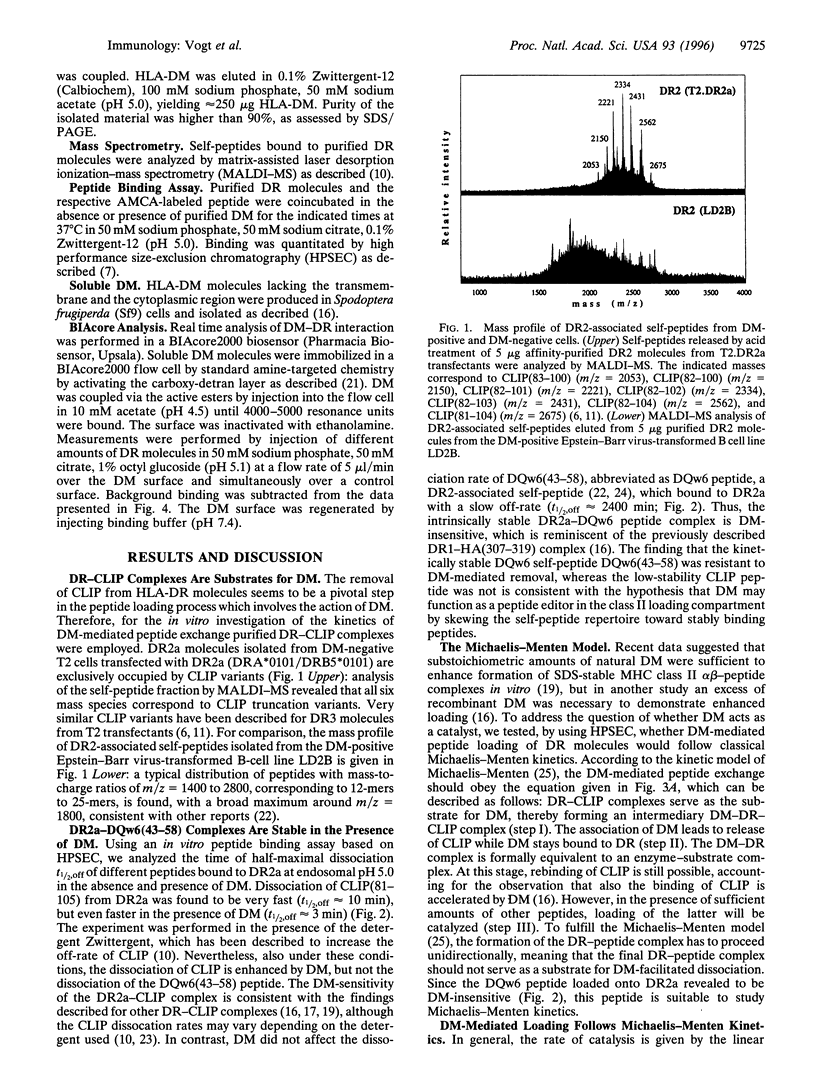
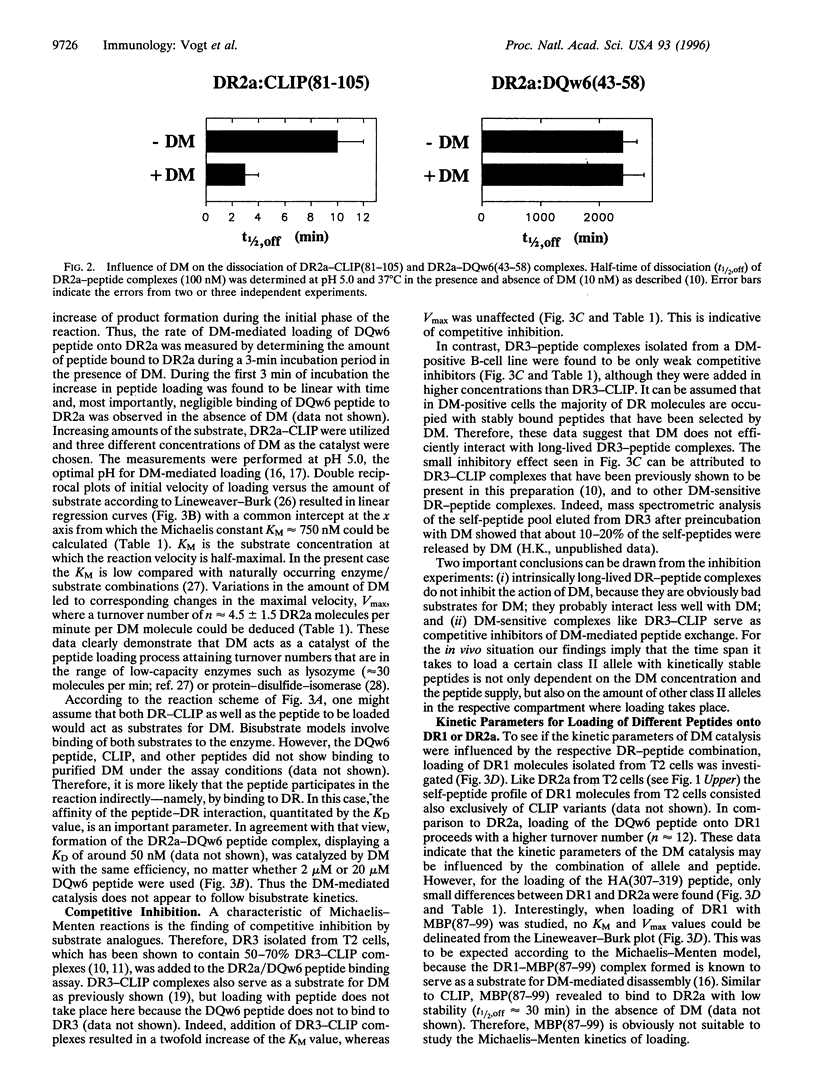
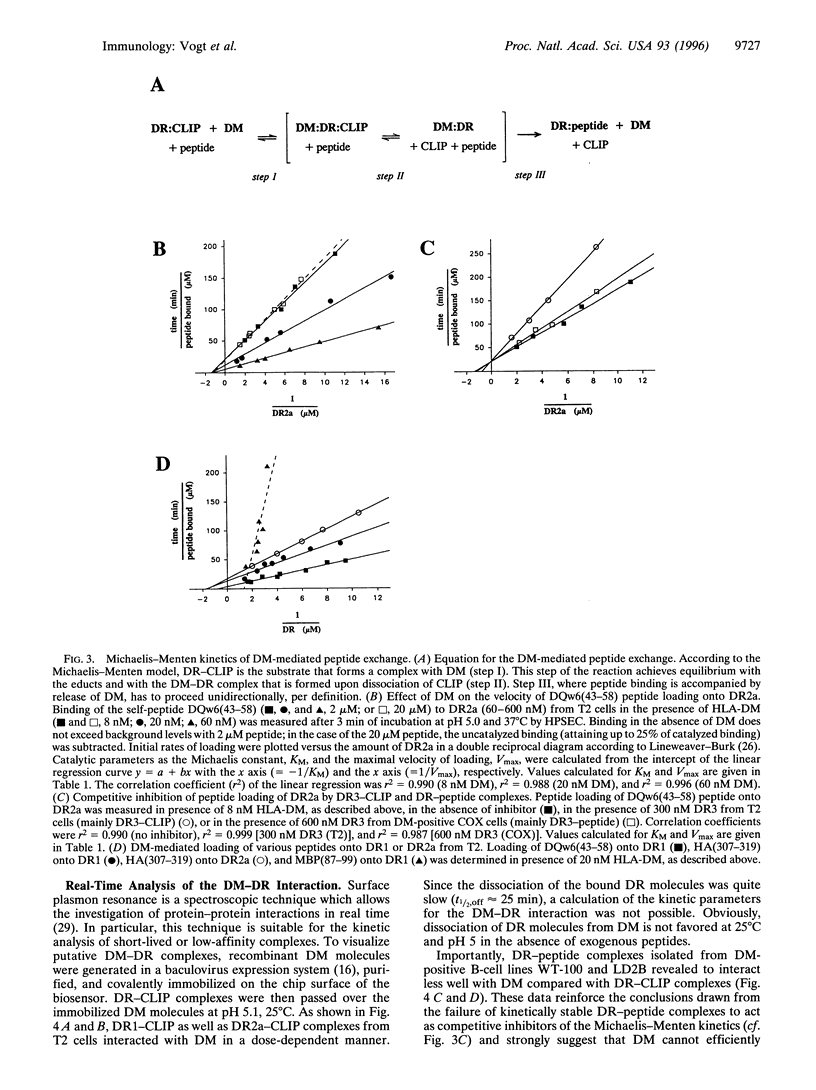
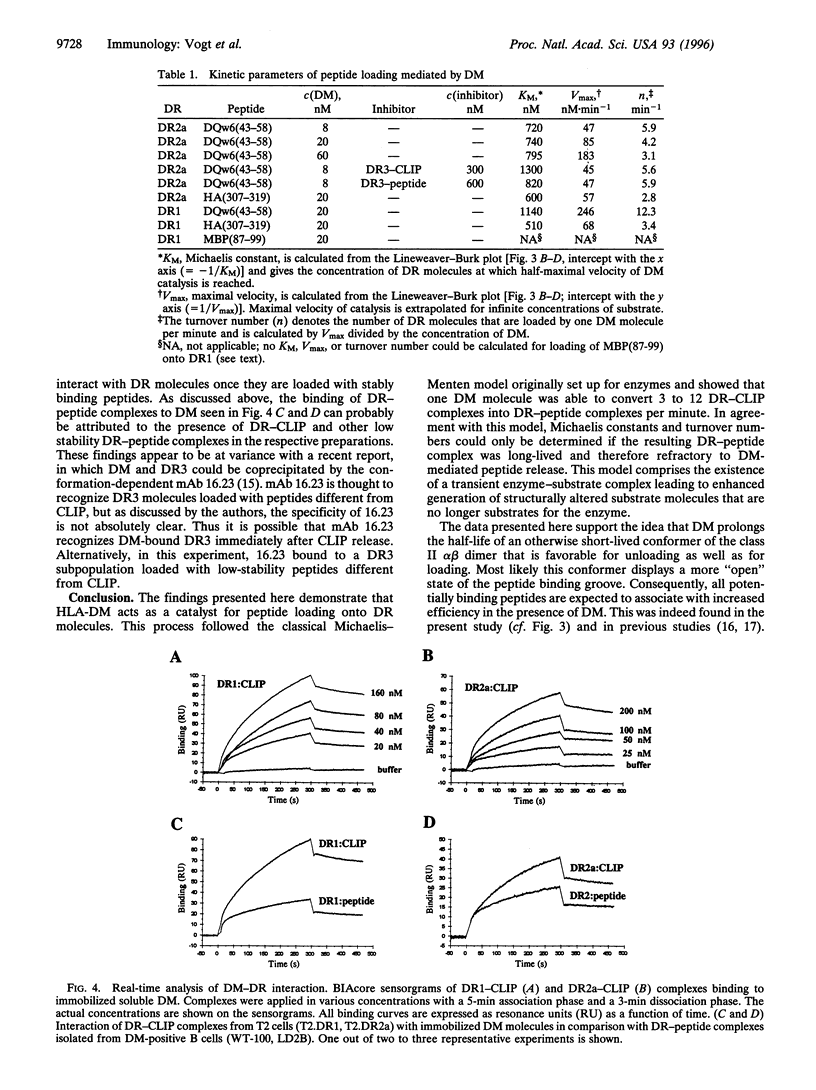
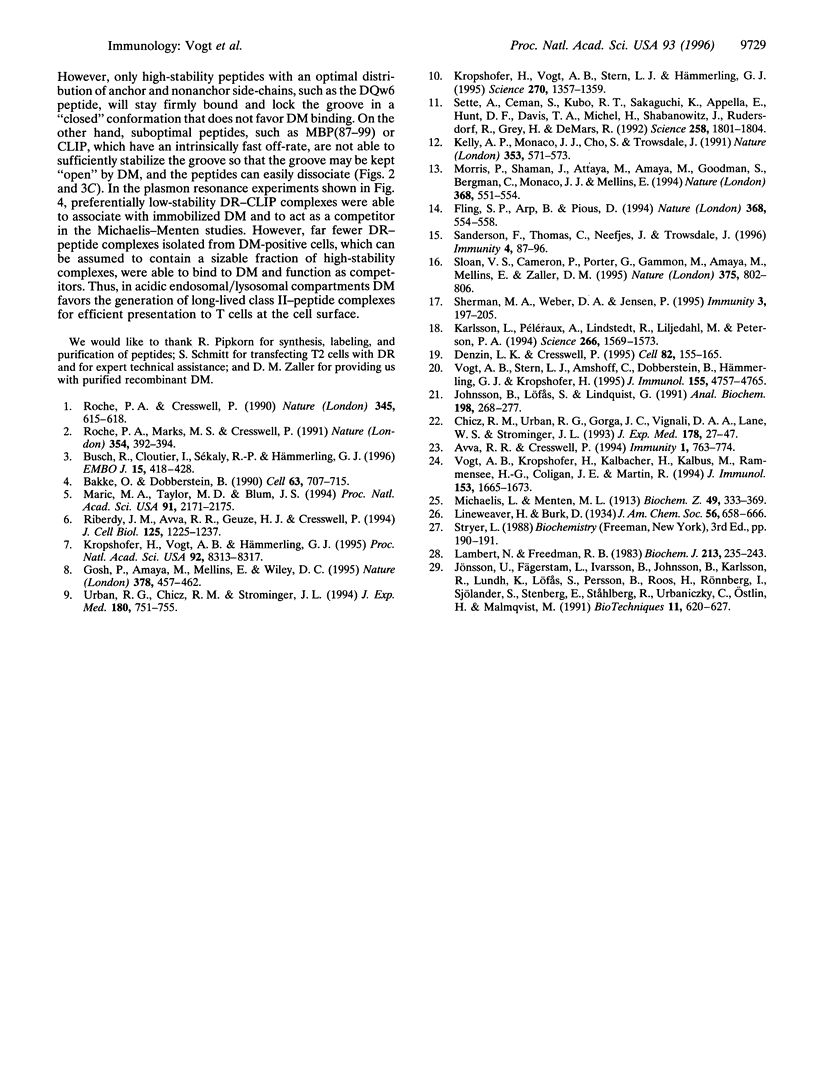
Selected References
These references are in PubMed. This may not be the complete list of references from this article.
- Avva R. R., Cresswell P. In vivo and in vitro formation and dissociation of HLA-DR complexes with invariant chain-derived peptides. Immunity. 1994 Dec;1(9):763–774. doi: 10.1016/s1074-7613(94)80018-9. [DOI] [PubMed] [Google Scholar]
- Bakke O., Dobberstein B. MHC class II-associated invariant chain contains a sorting signal for endosomal compartments. Cell. 1990 Nov 16;63(4):707–716. doi: 10.1016/0092-8674(90)90137-4. [DOI] [PubMed] [Google Scholar]
- Busch R., Cloutier I., Sékaly R. P., Hämmerling G. J. Invariant chain protects class II histocompatibility antigens from binding intact polypeptides in the endoplasmic reticulum. EMBO J. 1996 Jan 15;15(2):418–428. [PMC free article] [PubMed] [Google Scholar]
- Chicz R. M., Urban R. G., Gorga J. C., Vignali D. A., Lane W. S., Strominger J. L. Specificity and promiscuity among naturally processed peptides bound to HLA-DR alleles. J Exp Med. 1993 Jul 1;178(1):27–47. doi: 10.1084/jem.178.1.27. [DOI] [PMC free article] [PubMed] [Google Scholar]
- Denzin L. K., Cresswell P. HLA-DM induces CLIP dissociation from MHC class II alpha beta dimers and facilitates peptide loading. Cell. 1995 Jul 14;82(1):155–165. doi: 10.1016/0092-8674(95)90061-6. [DOI] [PubMed] [Google Scholar]
- Fling S. P., Arp B., Pious D. HLA-DMA and -DMB genes are both required for MHC class II/peptide complex formation in antigen-presenting cells. Nature. 1994 Apr 7;368(6471):554–558. doi: 10.1038/368554a0. [DOI] [PubMed] [Google Scholar]
- Ghosh P., Amaya M., Mellins E., Wiley D. C. The structure of an intermediate in class II MHC maturation: CLIP bound to HLA-DR3. Nature. 1995 Nov 30;378(6556):457–462. doi: 10.1038/378457a0. [DOI] [PubMed] [Google Scholar]
- Johnsson B., Löfås S., Lindquist G. Immobilization of proteins to a carboxymethyldextran-modified gold surface for biospecific interaction analysis in surface plasmon resonance sensors. Anal Biochem. 1991 Nov 1;198(2):268–277. doi: 10.1016/0003-2697(91)90424-r. [DOI] [PubMed] [Google Scholar]
- Jönsson U., Fägerstam L., Ivarsson B., Johnsson B., Karlsson R., Lundh K., Löfås S., Persson B., Roos H., Rönnberg I. Real-time biospecific interaction analysis using surface plasmon resonance and a sensor chip technology. Biotechniques. 1991 Nov;11(5):620–627. [PubMed] [Google Scholar]
- Karlsson L., Péléraux A., Lindstedt R., Liljedahl M., Peterson P. A. Reconstitution of an operational MHC class II compartment in nonantigen-presenting cells. Science. 1994 Dec 2;266(5190):1569–1573. doi: 10.1126/science.7985028. [DOI] [PubMed] [Google Scholar]
- Kelly A. P., Monaco J. J., Cho S. G., Trowsdale J. A new human HLA class II-related locus, DM. Nature. 1991 Oct 10;353(6344):571–573. doi: 10.1038/353571a0. [DOI] [PubMed] [Google Scholar]
- Kropshofer H., Vogt A. B., Hämmerling G. J. Structural features of the invariant chain fragment CLIP controlling rapid release from HLA-DR molecules and inhibition of peptide binding. Proc Natl Acad Sci U S A. 1995 Aug 29;92(18):8313–8317. doi: 10.1073/pnas.92.18.8313. [DOI] [PMC free article] [PubMed] [Google Scholar]
- Kropshofer H., Vogt A. B., Stern L. J., Hämmerling G. J. Self-release of CLIP in peptide loading of HLA-DR molecules. Science. 1995 Nov 24;270(5240):1357–1359. doi: 10.1126/science.270.5240.1357. [DOI] [PubMed] [Google Scholar]
- Lambert N., Freedman R. B. Kinetics and specificity of homogeneous protein disulphide-isomerase in protein disulphide isomerization and in thiol-protein-disulphide oxidoreduction. Biochem J. 1983 Jul 1;213(1):235–243. doi: 10.1042/bj2130235. [DOI] [PMC free article] [PubMed] [Google Scholar]
- Marić M. A., Taylor M. D., Blum J. S. Endosomal aspartic proteinases are required for invariant-chain processing. Proc Natl Acad Sci U S A. 1994 Mar 15;91(6):2171–2175. doi: 10.1073/pnas.91.6.2171. [DOI] [PMC free article] [PubMed] [Google Scholar]
- Morris P., Shaman J., Attaya M., Amaya M., Goodman S., Bergman C., Monaco J. J., Mellins E. An essential role for HLA-DM in antigen presentation by class II major histocompatibility molecules. Nature. 1994 Apr 7;368(6471):551–554. doi: 10.1038/368551a0. [DOI] [PubMed] [Google Scholar]
- Riberdy J. M., Avva R. R., Geuze H. J., Cresswell P. Transport and intracellular distribution of MHC class II molecules and associated invariant chain in normal and antigen-processing mutant cell lines. J Cell Biol. 1994 Jun;125(6):1225–1237. doi: 10.1083/jcb.125.6.1225. [DOI] [PMC free article] [PubMed] [Google Scholar]
- Roche P. A., Cresswell P. Invariant chain association with HLA-DR molecules inhibits immunogenic peptide binding. Nature. 1990 Jun 14;345(6276):615–618. doi: 10.1038/345615a0. [DOI] [PubMed] [Google Scholar]
- Roche P. A., Marks M. S., Cresswell P. Formation of a nine-subunit complex by HLA class II glycoproteins and the invariant chain. Nature. 1991 Dec 5;354(6352):392–394. doi: 10.1038/354392a0. [DOI] [PubMed] [Google Scholar]
- Sanderson F., Thomas C., Neefjes J., Trowsdale J. Association between HLA-DM and HLA-DR in vivo. Immunity. 1996 Jan;4(1):87–96. doi: 10.1016/s1074-7613(00)80301-5. [DOI] [PubMed] [Google Scholar]
- Sette A., Ceman S., Kubo R. T., Sakaguchi K., Appella E., Hunt D. F., Davis T. A., Michel H., Shabanowitz J., Rudersdorf R. Invariant chain peptides in most HLA-DR molecules of an antigen-processing mutant. Science. 1992 Dec 11;258(5089):1801–1804. doi: 10.1126/science.1465617. [DOI] [PubMed] [Google Scholar]
- Sherman M. A., Weber D. A., Jensen P. E. DM enhances peptide binding to class II MHC by release of invariant chain-derived peptide. Immunity. 1995 Aug;3(2):197–205. doi: 10.1016/1074-7613(95)90089-6. [DOI] [PubMed] [Google Scholar]
- Sloan V. S., Cameron P., Porter G., Gammon M., Amaya M., Mellins E., Zaller D. M. Mediation by HLA-DM of dissociation of peptides from HLA-DR. Nature. 1995 Jun 29;375(6534):802–806. doi: 10.1038/375802a0. [DOI] [PubMed] [Google Scholar]
- Urban R. G., Chicz R. M., Strominger J. L. Selective release of some invariant chain-derived peptides from HLA-DR1 molecules at endosomal pH. J Exp Med. 1994 Aug 1;180(2):751–755. doi: 10.1084/jem.180.2.751. [DOI] [PMC free article] [PubMed] [Google Scholar]
- Vogt A. B., Kropshofer H., Kalbacher H., Kalbus M., Rammensee H. G., Coligan J. E., Martin R. Ligand motifs of HLA-DRB5*0101 and DRB1*1501 molecules delineated from self-peptides. J Immunol. 1994 Aug 15;153(4):1665–1673. [PubMed] [Google Scholar]
- Vogt A. B., Stern L. J., Amshoff C., Dobberstein B., Hämmerling G. J., Kropshofer H. Interference of distinct invariant chain regions with superantigen contact area and antigenic peptide binding groove of HLA-DR. J Immunol. 1995 Nov 15;155(10):4757–4765. [PubMed] [Google Scholar]


